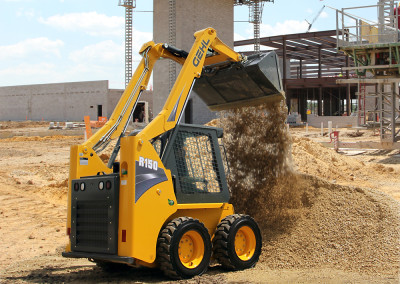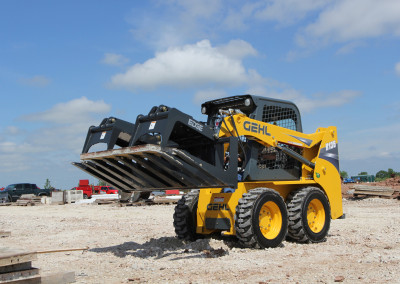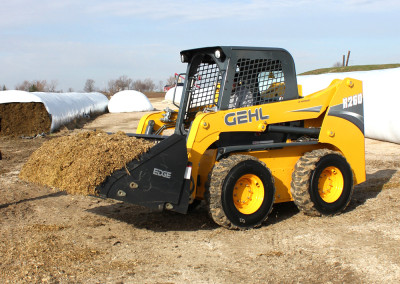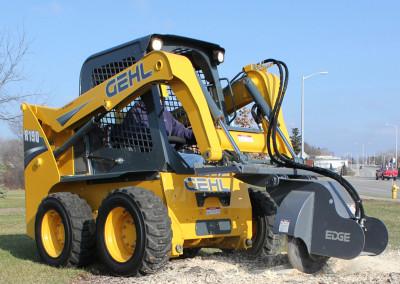Skid Loaders
current modelsAt King Machinery we have the right skid loader for your project. A skid loader is a small loader utilizing four wheels with hydraulic drive that directs power to either, or both, sides of the vehicle. Very similar in appearance and design is the track loader, which utilizes a continuous track on either side of the vehicle instead of the wheels. Since the expiration of Bobcat’s patent on its quick-connect system, newer tractor models are standardizing on that popular format for front end attachments.
Like Any Equipment You See?
What do skid loaders do?
Compact Skid Loaders
A skid loader or skid steer loader is a rigid frame, engine-powered machine with lift arms used to attach a wide variety of labor-saving tools or attachments. Though sometimes they are equipped with tracks, skid-steer loaders are typically four-wheel drive vehicles with the left-side drive wheels independent of the right-side drive wheels. By having each side independent of the other, wheel speed and direction of rotation of the wheels determine the direction the loader will turn.
Skid steer loaders are capable of zero-radius, “pirouette” turning, which makes them extremely maneuverable and valuable for applications that require a compact, agile loader.
Unlike in a conventional front loader, the lift arms in these machines are alongside the driver with the pivot points behind the driver’s shoulders. Because of the operator’s proximity to moving booms, early skid loaders were not as safe as conventional front loaders, particularly during entry and exit of the operator. Modern skid loaders have fully-enclosed cabs and other features to protect the operator. Like other front loaders, it can push material from one location to another, carry material in its bucket or load material into a truck or trailer.
Operation A Skid Steer loader can sometimes be used in place of a large excavator by digging a hole from the inside. The skid loader first digs a ramp leading to the edge of the desired excavation. It then uses the ramp to carry material out of the hole. The skid loader reshapes the ramp making it steeper and longer as the excavation deepens. This method is particularly useful for digging under a structure where overhead clearance does not allow for the boom of a large excavator, such as digging a basement under an existing house.
The conventional bucket of many skid loaders can be replaced with a variety of specialized buckets or attachments, many powered by the loader’s hydraulic system. These include backhoe, hydraulic breaker, pallet forks, angle broom, sweeper, auger, mower, snow blower, stump grinder, tree spade, trencher, dumping hopper, ripper, tillers, grapple, tilt, roller, snow blade, wheel saw, cement mixer, and wood chipper.
History The first three-wheeled, front-end loader was invented by brothers Cyril and Louis Keller (manufacturer) in Rothsay, Minnesota, in 1957. The Kellers built the loader to help a farmer mechanize the process of cleaning turkey manure from his barn. The light and compact machine, with its rear caster wheel, was able to turn around within its own length, while performing the same tasks as a conventional front-end loader.
The Melroe brothers, whose Melroe Manufacturing Company in Gwinner, N.D., purchased the rights to the Keller loader in 1958 and hired the Kellers to continue refining their invention. As a result of this partnership, the M-200 Melroe self-propelled loader was introduced at the end of 1958. It featured two independent front-drive wheels and a rear caster wheel, a 12.9-hp engine and a 750-lb. lift capacity. Two years later they replaced the caster wheel with a rear axle and introduced the M-400, the first four-wheel, skid-steer loader. It quickly became the Melroe Bobcat. The term “Bobcat” is sometimes used as a generic term for skid-steer loaders. The M-440 was powered by a 15.5-hp engine and had an 1100-lb. rated operating capacity. Skid-steer development continued into the mid-1960s with the M600 loader.
Many manufacturers have now made their variation of the skidloader, including: John Deere, Case, JLG, JCB, New Holland, Gehl, Mustang, ASV, Caterpillar and more.










